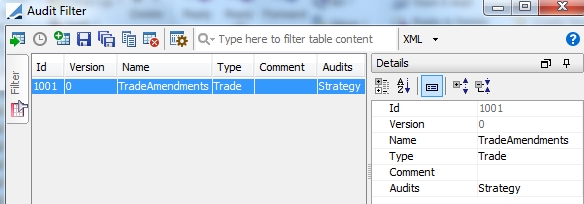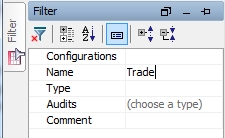Defining Audit Filters
An audit filter is a set of audit fields that can be monitored to determine if a process can be performed.
Audit filters are currently used in the following processes:
| • | To determine if a message should be regenerated in case a trade is modified, and the modified fields belong to the audit filter associated with the message configuration. |
| • | To determine if a workflow action should be applied in case a trade is modified, and the modified fields belong to the audit filter associated with the action. |
From the Calypso Navigator, choose Configuration > Filters > Audit Filter to define audit filters (menu action refdata.audit.AuditFilterWindow).

Audit Filter window
| » | All existing filters are loaded by default. |
You can filter the list of audit filters using the Filter tab, as needed.

| » | You can click |
| » | Audit Filters are identified by their name throughout the system. |
1. Creating Audit Filters
| » | Click |
| » | Enter the fields described below in the Details panel. |
| » | Click |
Note that if the Authorization mode is enabled, an authorized user must approve your entry.
Fields Details
|
Fields |
Description |
||||||||||||
|---|---|---|---|---|---|---|---|---|---|---|---|---|---|
|
Id |
ID given by the system upon saving. |
||||||||||||
| Version | Version number given by the system upon saving. | ||||||||||||
|
Name |
Enter the name that will identify the audit filter throughout the system. |
||||||||||||
| Type |
Select the reference object where the fields are coming from. Currently, you can select Trade. |
||||||||||||
| Audits |
Click to select the fields of the audit filter.
Ⓘ [NOTE: Product fields are not supported by the audit filter] |
2. Displaying Pending Authorizations
| » | Click |
